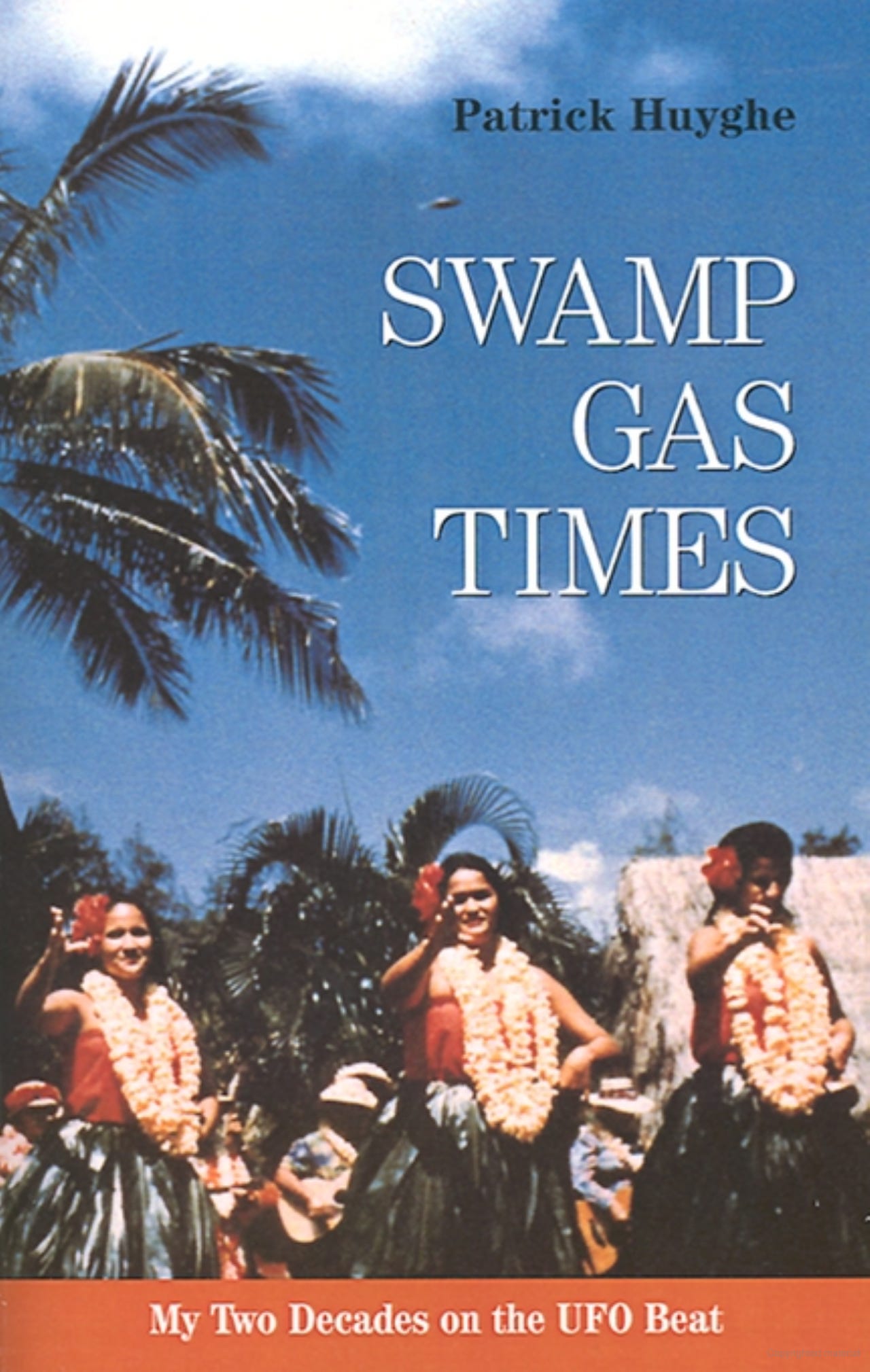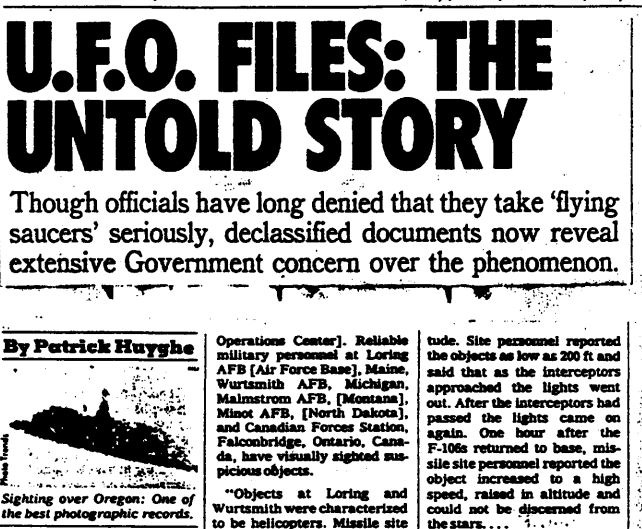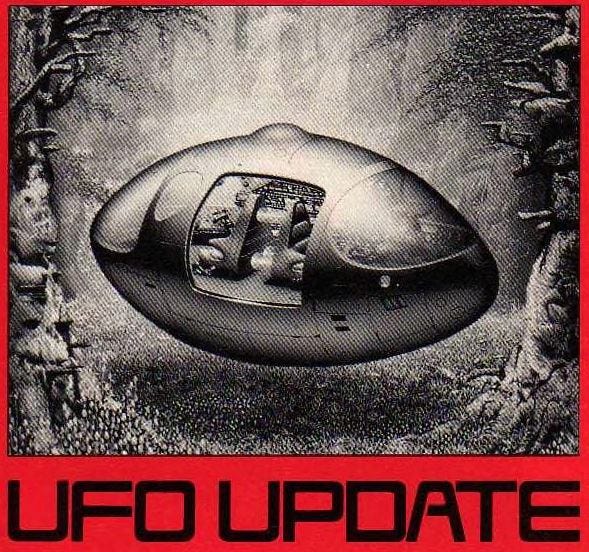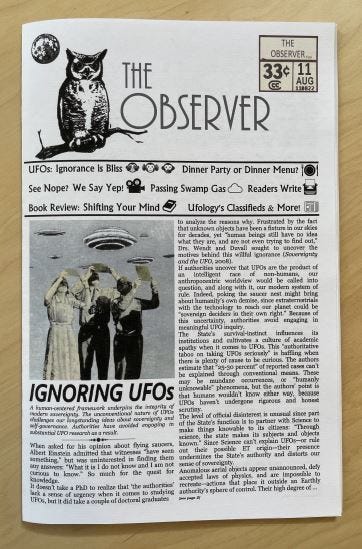In the era before “that UFO article in the New York Times” meant the 2017 write-up by Cooper, Blumenthal, and Keane, there was the 1979 report by journalist Patrick Huyghe. His piece for the New York Times Magazine (“UFO Files: The Untold Story”) revealed the existence of previously unknown UFO research projects, reports of unidentified craft violating military airspace, and an official attempt to downplay the whole thing—the same elements that made the 2017 NYT articles such a paradigm- changer. Four decades prior to the world learning about AAWSAP, AATIP, or Luis Elizondo, Huyghe concluded that the government’s formal interest in aerial anomalies never diminished: “Despite official denials to the contrary, Federal agencies continue to monitor the phenomenon to this day.”
This feeling of déjà vu was a constant companion during a recent reading of Swamp Gas Times (2001), a collection of Patrick Huyghe’s UFO-related work from the waning years of the 20th century. In fact, the book had us double-checking the copyright page more than once, since many of the topics covered parallel the UFO situation as it stands today.
Huyghe’s time on the “UFO beat” technically began with the teenage flying saucer magazine he started on the heels of the 1966 Michigan sightings. His interest eventually led to an impressive résumé that included a 10-year stint authoring a UFO column for OMNI magazine. (See mom? Writing about aliens and flying saucers is a real job!)
As his career progressed, so did Huyghe’s access. In 1978 he landed an interview with Project Blue Book astronomer J. Allen Hynek who shared plans for his recently created Center for UFO Studies (CUFOS). Dr. Hynek dreamed of creating a network of “amateur and professional investigators” that could tackle the issue with the aid of university-affiliated scientists. If this approach sounds familiar, that’s because it’s the same one being employed decades later by Harvard astronomer Avi Loeb’s Galileo Project. Much like Hynek’s vision, Loeb’s UFO-hunting initiative also calls for an amalgamation of public and private sector employees.
Huyghe covered other bits of UFO history with present-day relevance, like his 1988 report on “NASA’s Role in UFO Research.” His article depicts a space agency with a much different attitude than its latest iteration. NASA originally declined to join the UFO sky-watching party when they were approached in 1977, calling the effort “wasteful and unproductive.” The agency was scared into paralysis by the very public they were tasked to represent, deciding that a UFO investigation “would not satisfy the believers if the results were negative or the critics if the results were positive.” Instead of being proactive, the one group capable of reaching the cosmos was content to let others scan the sky. A succinct quote from a federal aviation official summarized their attitude perfectly: “If you get a piece of the thing, fine. But don't bother me with anything else.”
The agency’s past UFO avoidance is interesting in light of their recent interest in the topic. They announced in June of this year that they were jumping into the UFO fray with a team of scientists—although how much they expect to learn with only a $100k budget isn’t exactly clear.
Huyghe goes on to pinpoint 1989 as the year the wheels came off ufology, and he might be right.
“All the wacky stories suddenly rose to the fore.” 1989 was when Bill Moore gave his famous “disinfo agent” speech at the Las Vegas MUFON Conference; it was also the first time Bob Lazar was interviewed about his claims to have worked on extraterrestrial craft at Area 51. In 1989, crop circles were settling into farmer’s fields and onto bookstore shelves, while below the ground, aliens were allegedly experimenting on humans in secret bases.
His assessment of “the UFO business” accompanied a 1989 interview with UFO personality John Lear. Lear promoted the ‘evil-ET’ hypothesis, warning others about the alien conspiracy to subjugate humanity. Huyghe’s article portrays the period’s “can you top this quality” perfectly when Lear alleges that the government is in league with extraterrestrials who are liquefying human and animal body parts into a nutrient-rich compound that they absorb through their skin for nourishment.
Lear’s anecdotes may seem outlandish and outdated, but one could argue that they are still viable today—reflected in current political myths about sinister reptilians and baby-eating elites working in cahoots to take over the planet.
Huyghe’s compilation contains other asides that add color and context to the modern-day UFO discussion. From a rare missed-call on the staying power of Erich von Däniken’s ancient astronaut thesis (including this gem from the editor of Skeptical Inquirer: “I just don’t know anybody who takes this seriously anymore”—tell that the 18 seasons of Ancient Aliens!), to a story about those Bigelow-backed-boys in the National Institute of Discovery Sciences, many of the topics can be connected by a straight line to contemporary UFO narratives.
(Incidentally, Huyghe also mentions the existence of an official NIDS brochure and sticker that the group mailed to various media outlets and first responders back in the 1990s. We desperately want to get our hands on one of those stickers! The article also lists the number for the NIDS incident reporting hotline – 702-798-1700 – someone call and see if Colm Kelleher answers!)
Swamp Gas Times amounts to more than a portfolio of UFO articles. The book contains snapshots documenting moments in time that add important context to current events. The same challenges and storylines surrounding the phenomenon 40 years ago are still around today. This overlap is a sober reminder of how little things change in the world of UFOs.
What’s that old saying about those who don’t study history?












